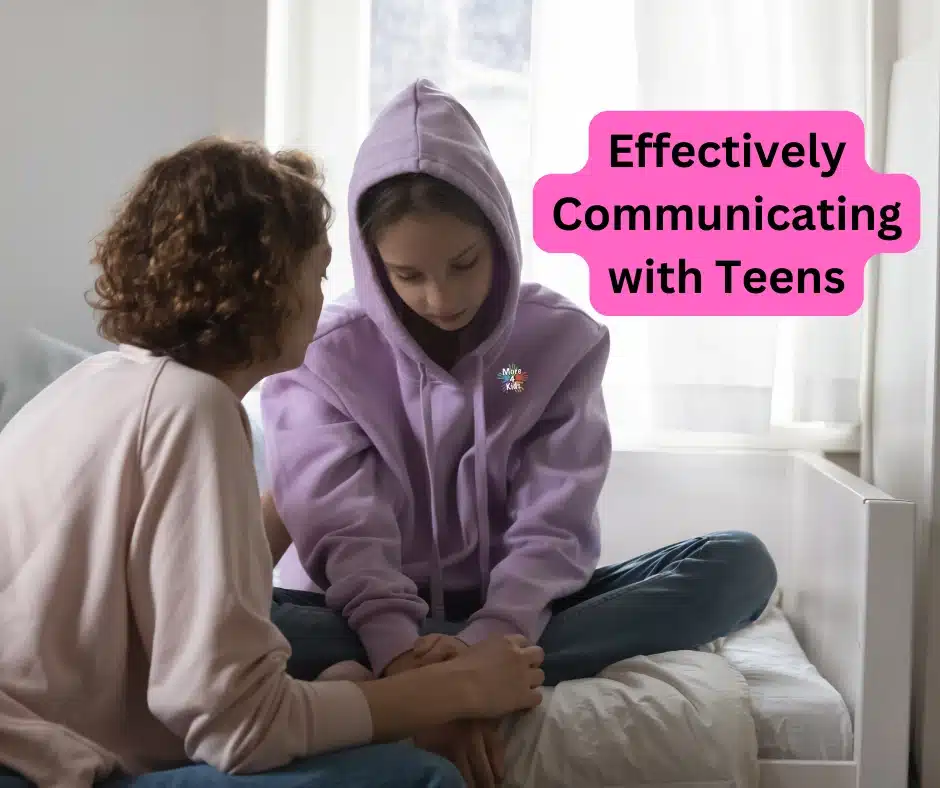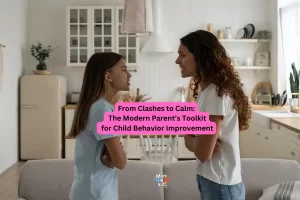What helps with effectively communicating with your teen? In the age of smartphones and digital devices, we have access to a wealth of information and conveniences that were once unimaginable. From instant communication to online shopping, mobile technology has revolutionized how we live. However, this increased reliance on digital devices has also brought new challenges, particularly when communicating effectively with teenagers.
Research shows that many teens spend up to nine hours daily on their mobile devices, which can hinder face-to-face communication and interpersonal relationships. In this article, we will explore the breakdown of effective communication with our teens, along with practical strategies for building trust and understanding with teenagers in the digital age, while acknowledging mobile technology’s unique challenges.
Why is communication with teens so challenging?
Table of Contents
Living with and communicating with teenagers can be challenging for so many reasons. An article titled ABC of Adolescence published by The BMJ indicates that communication can be difficult because of the changes that occur during adolescence. During this time, teenagers are experiencing significant physical, emotional, and cognitive changes, making it harder for them to express themselves and understand others. Additionally, teenagers are often trying to establish their independence and may be less likely to seek guidance or advice from adults.
The prevalence of digital technology adds another layer of complexity. While mobile devices can provide a convenient way to stay connected, they can also be a source of distraction and may limit opportunities for face-to-face communication. Further, while teens may be spending a lot of time online, their parents are too. Depending on your source of the truth, the average American spends somewhere between three to just over five hours on their devices per day.
This device proliferation and active use can make it harder to build trust and understanding with teenagers (on both sides of the coin), as nonverbal cues and other essential aspects of communication may be lost in digital interactions. However, by recognizing these challenges and developing strategies to overcome them, adults can build stronger, more meaningful relationships with teenagers.
The impact of digital technology on interpersonal communication
Go online and search for the impact of digital technology on interpersonal communication, and you’ll be inundated with hits. That’s because this phenomenon and concern aren’t new. But unfortunately, the problem seems to be worsening instead of getting better. A Frontiers article published by the National Library of Medicine, shares that while technology has made it easier than ever to stay connected with others, it can also hinder face-to-face interactions and communication skills.
Consider the following:
- Technology can limit nonverbal cues, such as facial expressions and body language, hindering accurate interpretation of messages and emotions.
- This same reliance on technology can lead to distraction in social settings. Teens may check their social media accounts, play games, or engage in other digital activities instead of focusing on those around them, leading to feelings of disconnection and reduced engagement in meaningful conversations.
- Technology can make avoiding difficult or uncomfortable conversations easier, as teenagers may turn to text or social media to communicate rather than face-to-face, leading to miscommunication and a lack of deeper connection.
To improve communication skills and build stronger relationships, teens need assistance to balance technology use with face-to-face interactions. Further, they need help learning to appreciate and recognize potential distractions and miscommunication.
An increase in digital technology usage in the school setting

One of the key differences between online and face-to-face learning is the lack of personal interaction and connection. Without the ability to engage with peers and teachers in person, students may struggle to build relationships and feel a sense of community within the classroom.
Furthermore, the shift to remote learning has also meant an increase in the use of technology in education. While technology can provide new opportunities for learning and engagement, it can also lead to distractions and a lack of focus. This can impact communication between teachers and students, between students and their parents, and in peer to peer relationships between students themselves. Without the benefit of face-to-face interactions, it can be harder to pick up on nonverbal cues and ensure that messages are being understood.
While digital learning comes with a host of advantages, the increased reliance on technology for education can further contribute to the challenges of communicating with teenagers in a meaningful way. Simply stated, digital interactions may lack the depth and nuance of in-person conversations.
Signs your teen might be taking too much screen time
Between personal use of mobile devices and the increased usage of technology in schools, there is no doubt that today’s teens spend more time online than any of us could have imagined. So as technology continues to play an increasingly prominent role in the lives of children and teenagers, it can be challenging for parents to determine how much screen time is too much.
While limiting screen time may be necessary to promote healthy development and good sleep habits, it’s also important to acknowledge that digital devices are an essential part of modern life. Stopping screen time altogether isn’t a realistic solution, especially given the role that technology plays in education. Instead, it’s important for parents to be aware of the signs that their child may be spending too much time in front of a screen, and to find ways to encourage healthy habits without creating a sense of hostility or disconnection.
According to the University of Michigan, some of the signs that a child may be spending too much time in front of the screen include:
- Becoming irritable or angry when not allowed to use technology
- Neglecting social relationships in favor of screen time
- Experiencing sleep disturbances due to so much time in front of the screen
- Using technology to escape from problems or negative emotions
- Becoming defensive or secretive about their technology use, including hiding their device, or puting it out of sight when their parents walk in the room
- Experiencing physical symptoms such as headaches or eye strain
By being aware of these signs and monitoring their child’s screen time, parents can take steps to promote healthy technology habits and prevent the negative effects of excessive screen time. This may involve setting limits on screen time, encouraging other activities, and modeling healthy technology habits themselves
Shifting away from the screen
If you’re looking to reduce your teenager’s screen time, the National Heart, Lung, and Blood Institute recommends taking small steps and making gradual changes. To that end, shifting away from the screen won’t automatically improve communication between parent and child, from sibling to sibling, or even from your teen to their friends.
Here are some tips to help you reduce your child’s screen time:
- Set clear limits – Establish clear guidelines for screen time and stick to them. This could involve limiting screen time to a certain number of hours per day or week, or setting specific times when screens are off-limits (such as during mealtimes or before bedtime).
- Encourage physical activity – Encourage your teen to participate in school sports, extra-curricular activities, and other non-screen activities, such as reading, cooking, baking, or exploring their artistic abilities. This can reduce boredom and provide alternative ways for your teen to spend their time while developing new interests.
- Create screen-free zones – Come up with some family rules that make certain areas of your home as screen-free zones. This might mean the dinner table during family meals or bedrooms for one hour before bedtime. This can help to reinforce the idea that screens are not a constant presence in our lives.
- Model healthy habits – Model healthy technology habits yourself. This means limiting your own screen time and avoiding distractions when spending time with your teenager, participating in activities that interest them. This means that if you roll out a no screen rule in the bedrooms or at the dinner table for them, then you shouldn’t do it either.
Building trust and effective communication with your teen
We can’t stress enough that reducing screen time and building effective communication with your teen will not happen overnight. Further, as parents, we need to think back in time and remember that being a teenager is hard. Adolescents face many challenges as they navigate the complex transition from childhood to adulthood. These young adults often get a bad rap, too, but the truth is that they’re dealing with a lot.
Today’s teens are under immense pressure to succeed academically, socially, and emotionally. According to a recent study, the top six causes of teen stress and pressure include academic expectations, negative peer pressure, societal pressures, physical appearance, family problems, and traumatic events. Negative peer pressure can lead to risky behavior, low self-esteem, and even depression. While it’s important to encourage teens to set high standards for themselves, it’s equally important to acknowledge the challenges they face and provide them with the tools they need to cope with stress and succeed in a healthy and sustainable way.

- Listen actively – Make an effort to really listen to your teen when they talk. Put away any distractions and focus on what they’re saying.
- Validate their feelings – Show your teen that you understand and acknowledge their feelings. Let them know that it’s okay to feel how they feel, even if you don’t necessarily agree with them.
- Avoid being judgmental – Try to approach conversations with your teen in a non-judgmental way. This will help to create a safe environment where they feel comfortable sharing their thoughts and feelings with you.
- Be patient – Communication with teenagers may not come easily or quickly. Be patient and persistent in your efforts to connect with them. Keep the lines of communication open, even if it feels like they’re not reciprocating.
- Find common ground – Look for opportunities to bond with your teen over shared interests or hobbies. This can help to build a stronger connection and create a more positive environment for communication.
Appreciating the strong connection between teen and mobile device
As we’ve discussed, mobile devices have become a crucial tool for communication among teenagers. Taking away a teenager’s phone can feel like an attack on their social life and personal autonomy, which can actually exacerbate communication problems.
In an article for Child Mind Institute, Beth Peters, PhD, a clinical psychologist in Westminster, Colorado, who specializes in teens and families, is quoted as saying “To adolescents the social network and contact with friends is the paramount developmental task and focus. When you remove a teen’s lifeline to their friends, there will be a major emotional backlash, a breakdown of the parent-child relationship.” She goes on to say that kids tend to withdraw from the parent. “They don’t try to solve their problem. They don’t talk to the parent. You’re really setting yourself up for a dishonest teen because they need that contact and will resort to sneaky behavior to get it.”
For this reason, simply limiting a teenager’s phone usage may not be enough or the right approach to solve issues with communication. But that doesn’t mean there aren’t steps that parents can take to help their teens find a healthy balance between phone usage and face-to-face communication. One strategy is to encourage activities that involve both phone usage and social interaction, such as group video chats or online games with friends (or parents).
Additionally, parents can work with their teens to set boundaries and limits around phone usage, such as turning off phones during mealtimes or for a pre-determined amount of time before bedtime. Note, The National Sleep Foundation recommends that you should stop using electronic devices, like your cellphone, at least 30 minutes before bedtime.
When screen time disengagement strategies don’t work
But what should parents do when the recommended strategies to get teens to disengage from their mobile devices and connect one on one don’t work? Parents must understand the potential risks of internet addiction and when additional intervention may be necessary. Internet addiction can have negative effects on a teen’s mental health, social skills, and academic performance.
It can also make it difficult for parents to establish open and effective communication with their teens, hindering the development of trust and healthy relationships. By being aware of the signs of internet addiction and seeking help when needed, parents can support these young adults in developing healthy technology habits and improving their communication skills, ultimately strengthening their relationship with their teens.
How can I build trust and improve communication with my teen in this digital age?
Listening actively, validating their feelings, avoiding judgment, being patient, and finding common ground can all help build trust and improve communication. It’s also important to appreciate the strong connection between teens and their mobile devices; finding a balance between phone usage and face-to-face interaction can be key. If standard strategies don’t work, be aware of the signs of internet addiction and seek help when needed.
How does digital technology impact interpersonal communication with teenagers?
Digital technology can limit opportunities for face-to-face communication, leading to the loss of nonverbal cues like facial expressions and body language. It can also be a source of distraction, impeding the quality of interactions and causing feelings of disconnection. Digital technology might also enable teens to avoid difficult or uncomfortable conversations, leading to potential miscommunication.
Why is effective communication with teenagers so challenging in the digital age?
Effective communication with teens can be challenging due to their increased reliance on digital devices, a natural part of their social development and the need for independence. Additionally, teens are undergoing significant physical, emotional, and cognitive changes, which may complicate communication. Digital interactions may also lack the depth and nuance of face-to-face conversations.
What are some signs that my teen might be spending too much time on their digital devices?
Some signs of excessive screen time include irritability when not allowed to use technology, neglecting social relationships in favor of screen time, sleep disturbances, using technology to escape from problems, and physical symptoms like headaches or eye strain. Teens might also become defensive or secretive about their technology use.
How can I help reduce my teenager’s screen time?
Establish clear guidelines for screen time and encourage physical and other non-screen activities. Create screen-free zones in your home and model healthy technology habits yourself. Remember, it’s about balance, not complete elimination of screen time.













Add Comment